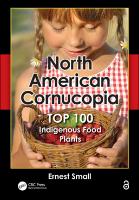North American Cornucopia
Proposal review
Top 100 indigenous food plants
| dc.contributor.author | Small, Ernest | |
| dc.date.accessioned | 2020-07-23T15:36:26Z | |
| dc.date.available | 2020-07-23T15:36:26Z | |
| dc.date.issued | 2013 | |
| dc.identifier | ONIX_20200723_9781466585928_22 | |
| dc.identifier | ONIX_20200723_9781466585928_22 | |
| dc.identifier | OCN: 901239842 | |
| dc.identifier.uri | https://library.oapen.org/handle/20.500.12657/41771 | |
| dc.description.abstract | Many North American plants have characteristics that are especially promising for creating varieties needed to expand food production, and there are excellent prospects of generating new economically competitive crops from these natives. The inadequacy of current crops to meet the food demands of the world’s huge, growing population makes the potential of indigenous North American food plants even more significant. These plants can also generate crops that are more compatible with the ecology of the world, and many also have inherent health benefits. Presenting detailed scholarship, a thoroughly accessible style, and numerous entertaining anecdotes, North American Cornucopia: Top 100 Indigenous Food Plants is a full-color book dedicated to the most important 100 native food plants of North America north of Mexico that have achieved commercial success or have substantial market potential. The introductory chapter reviews the historical development of North American indigenous crops and factors bearing on their future economic success. The rest of the book consists of 100 chapters, each dedicated to a particular crop. The book employs a user-friendly chapter format that presents the material in sections offering in-depth coverage of each plant. The first section of each chapter provides information on the scientific and English names of the plants, followed by a section on the geography and ecology of the wild forms, accompanied by a map showing the North American distribution. A section entitled "Plant Portrait" comprises a basic description of the plant, its history, and its economic and social importance. This is followed by "Culinary Portrait," concerned with food uses and culinary vocabulary. The chapters then provide an analysis of the economic future of each crop, discuss notable and interesting scientific or technological observations and accomplishments, and present extensive references. | |
| dc.language | English | |
| dc.subject.classification | thema EDItEUR::P Mathematics and Science::PS Biology, life sciences::PST Botany and plant sciences | en_US |
| dc.subject.classification | thema EDItEUR::P Mathematics and Science::PS Biology, life sciences | en_US |
| dc.subject.classification | thema EDItEUR::T Technology, Engineering, Agriculture, Industrial processes::TV Agriculture and farming | en_US |
| dc.subject.other | Crop Science | |
| dc.subject.other | Botany | |
| dc.subject.other | CHOICE Recommended Title | |
| dc.subject.other | AGRICULTURE | |
| dc.subject.other | PlantSCIENCE | |
| dc.subject.other | BIOSCIENCE | |
| dc.subject.other | SCI-TECH | |
| dc.subject.other | LIFESCIENCE | |
| dc.subject.other | STM | |
| dc.subject.other | Economics | |
| dc.subject.other | Food Plants | |
| dc.subject.other | Indigenous Plants | |
| dc.subject.other | Native | |
| dc.subject.other | North American Plants | |
| dc.title | North American Cornucopia | |
| dc.title.alternative | Top 100 indigenous food plants | |
| dc.type | book | |
| oapen.identifier.doi | 10.1201/b15818 | |
| oapen.relation.isPublishedBy | 7b3c7b10-5b1e-40b3-860e-c6dd5197f0bb | |
| oapen.imprint | CRC Press | |
| oapen.pages | 801 | |
| peerreview.anonymity | Single-anonymised | |
| peerreview.id | bc80075c-96cc-4740-a9f3-a234bc2598f1 | |
| peerreview.open.review | No | |
| peerreview.publish.responsibility | Publisher | |
| peerreview.review.stage | Pre-publication | |
| peerreview.review.type | Proposal | |
| peerreview.reviewer.type | Internal editor | |
| peerreview.reviewer.type | External peer reviewer | |
| peerreview.title | Proposal review | |
| oapen.review.comments | Taylor & Francis open access titles are reviewed as a minimum at proposal stage by at least two external peer reviewers and an internal editor (additional reviews may be sought and additional content reviewed as required). |

